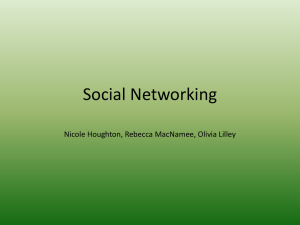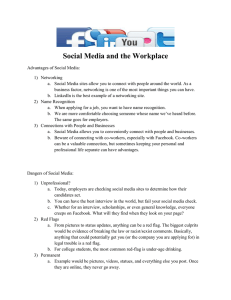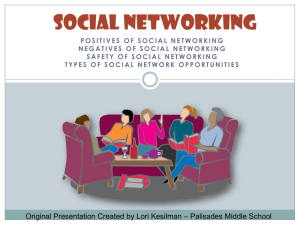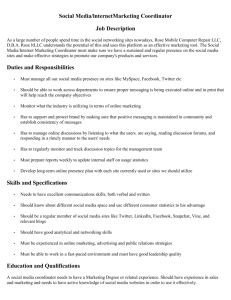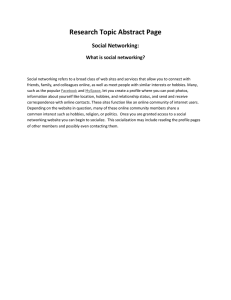Web 2.0: Clayton Badeaux Pooja Bhandari Trends and Controversy in User Created
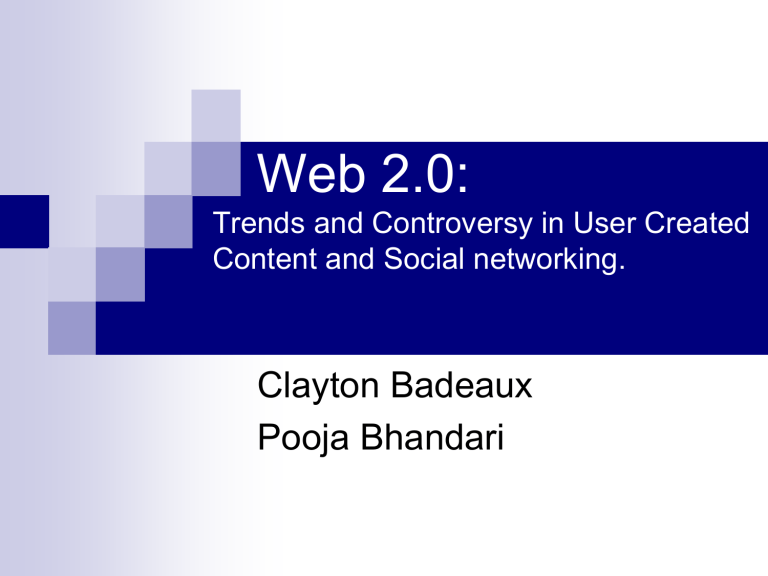
Web 2.0:
Trends and Controversy in User Created
Content and Social networking.
Clayton Badeaux
Pooja Bhandari
Agenda
Web 2.0
Social Networking
Major Players
Trends
Controversies
User-Generated Content
Major Players
Trends
Controversies
References
“Web 2.0
is the business revolution in the computer industry caused by the move to the Internet as a platform, and an attempt to understand the rules for success on that new platform” – Tim O’Reilly, Web 2.0 Conference 2004.
Technology
Web 2.0 uses AJAX, XML, RSS, and other technologies to create features of Searching, Linking, Authoring, Tags,
Extensions and Signals.
Philosophy
Web 2.0 provides a “network as a platform” philosophy that encourages an architecture of participation.
Social Networking
What is Social Networking?
History
Theglobe.com (1994)
Classmates.com (1995)
SixDegrees.com (1997)
Trust-Based, Friendship-Based models (1999)
Friendster, MySpace, Bebo (2002-04)
Facebook (2004-05)
Yahoo! 360 ° (2005)
Trends
Joe Kraus, Google's director of product management
Discovery : from solitary to social
Putting a status message
Waiting for people to chime in to help you
Google’s initiative in social search
Trends Contd..
Sharing : from active to passive
Emails
High social activation energy
Share less
Separating access to content from notification
Sender publishes
Receiver’s choice
Share more
Sites like Facebook, Flickr
Trends Contd..
Social : from site to web-wide
“Do” at a site
User Generated Content
Hubs of activity
Identity Fragmented
How to be “more social”?
Google Friend Connect
Trends Contd.
OpenSocial
Over 200 Social Networks
One profile
Associated “social graph”
Recent Standards
OpenID for identity
OAuth for API authorization
OpenSocial for building crosssite apps
Trends contd..
Aka-aki
Members know when they're near one another
GPS technology (Bluetooth) in cell phones
Diary of encounters
Google's newly launched Android cell phone
Life360, a location-based system
Commandro, a social networking application
History
Harvard University
The Facebook
Features
Wall
Status
Photos
Videos
News Feed
Chat
Notes
Figures
150 million users
15 million users update their status daily
850 million photos added per month
120 friends per user on average
Key Roles Played
Barack Obama presidential campaign
Controversies
Facebook’s Advertising Initiative
Backlash from privacy advocates and users
Users’ privacy concerns
Controversies
Change in Facebook’s content ownership policy
Privacy concerns
Site users risk losing control of personal information
Careful on what to post online
Controversies
Enterprises scrutinize social networking sites to vet job applicants
Violation of enterprise’s antidiscrimination policies
Information on social networking sites may not be verifiable
Bogus profiles
False details
User-Generated Content
Also known as “Conversational Media”, UGC is a key characteristic of Web 2.0, and the audience is prevailing today with accessible media, tools, and applications.
Examples of UGC:
Blogs
Video & Image sharing
Discussion Boards & Wikis
Social Networking
News Sites
E-Commerce Rating and Product Discussion
Trends in User Generated Content
Several business trends have appeared regarding UGC, related to both marketing and sales, and product support and services. We will address each trend separately, but they are often integrated in their execution.
Gartner Hype Cycle
Changing Business Models
Targeted Advertising
Viral Marketing
Trends:
Gartner Hype Cycle
Trends:
Changing Business Models
Business models should take account the impact of the web in all key business processes. Taking into account collective intelligence, networking, and cloud computing all effect the effectiveness of business models. While Web 2.0 emphasizes the consumer facing web, the business-to-business impact is increasing.
Emphasis of web-centric management of divisional manufacturing, procurement and global micro-business.
Software as a service, cloud computing, and Web platform capabilities reinforce outsourcing and focus on core competency.
Community collaboration and network based intelligence are driving business innovation, such as the viral dissemination of information through committed communities of web users.
Trends:
Targeted Advertising
Targeted Advertising functions by conveying advertising appropriate to the subject of the content.
Examples include:
Google search and application advertising
Amazon recommendations
Forum/review content advertisements
(such as gaming advertisements on gaming review websites).
Trends:
Viral Marketing
Viral marketing uses social networking and word of mouth advertising to create market demand for a product or service. This is also called “grassroots” marketing, and has been made easier by the growth of social networking sites such as MySpace, Twitter, and Facebook.
Examples:
President Obama’s 2008 Election Campaign
Movie and Product Facebook Groups
MySpace’s Music Referral Service
Controversy:
Business Integration
Business integration of user generated content has been difficult and controversial for traditional business. The
Gartner group has identified the following key points to successful integration:
Do not dismiss social software as a productivity plague.
Understand the risk and benefits of user generated content systems in your business processes and enterprises.
Assess the unique challenges facing UGC in the enterprise, and . . .
Prepare a strategy for introduction and integration of these new systems and technologies.
Controversy:
Copyright
Copyright of user generated works has continued to be controversial. Sites including Facebook, TurnItIn.com,
YouTube, and Digg have all faced legal threat or action regarding the copyright of content uploaded by users.
User vs. Website
TUSD vs. TurnItIn.com (2006)
Facebook TOS revision (2/15/2009)
3 rd Party Content Owner vs. Website
DMCA Violations (YouTube, Veoh, others)
Controversy:
Copyright User vs. Website
Federal courts dismissed one of the current lawsuits vs.
TurItIn.com saying that despite the archiving of a students complete work in their database it was used in a “transformational system” which prevented the students copyright from being violated.
Facebook’s revised Terms of Service never reached a court, as the backlash from their user base was so extreme that the changes were reverted within a few days to a previous version pending a new more community friendly revision being authored.
Controversy:
3 rd Party vs. Site Owners
The Digital Millennium Copyright Act (DMCA) has been a source of conflict and frustration since it was signed into law.
Safe Harbor Provision
Takedown notices
Burden of Proof
Content Creators and the DMCA
Definition of Fair Use
Response to Takedown
References
http://en.wikipedia.org/wiki/Social_networking
Google's view: Three trends in social networking, http://news.cnet.com/8301-17939_109-9970053-2.html
http://www.opensocial.org/
Yahoo, Google, MySpace form nonprofit OpenSocial Foundation, http://news.cnet.com/8301-13577_3-9902585-36.html
Social networking site to use state of the art technology, http://www.cnn.com/2009/TECH/02/03/myspace.sex.offenders/index.html?ir
ef=newssearch
Future of social networking collaboration, German company aka-aki's mission, http://www.cnn.com/2008/TECH/science/09/26/social.networking/index.html
?iref=newssearch
Gartner Report, Facebook's Advertising Initiative Gambles on
Weathering Backlash
Expert: Social networkers risk 'losing control' of privacy, http://www.cnn.com/2009/TECH/02/18/facebook.privacy/index.html
References Cont’d
Gartner Report ID Number: G00154464: How Web Business Models Are
Increasing Their Impact in the Web 2.0 Era; Charles Abrams
Gartner Report ID Number: G00158479: Hype Cycle for Content management 2008
Gartner Report: ID Number: G00154985: Five Major Challenges
Organizations Face Regarding Social Software http://en.wikipedia.org/wiki/User-generated_content: Wikipedia; User generated Content. http://www.insidefacebook.com/2009/02/16/zuckerberg-responds-toconcerns-about-facebooks-updated-terms-of-service/ Zuckenberg’s response about Facebooks Terms of use Changes. http://www.eff.org/deeplinks/2008/08/required-reading-user-generatedcontent-sites-io-g EFF Required Reading: Veoh vs. IoGroup
